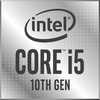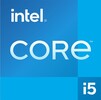Intel Core i5-1035G4 vs Intel Core i5-1250P
Intel Core i5-1035G4
► remove from comparison
The Intel Core i5-1035G4 is a low-power, Ice Lake family processor (SoC) featuring 4 cores, 8 threads, 6 MB of L3 cache and the Iris Plus G4 (48 EUs) iGPU. It saw the light of day in H2 2019. The chip is designed for use in highly portable laptops; its CPU cores run at 1.1 GHz to 3.7 GHz, with only 3.3 GHz achievable if all the cores are loaded.
Unlike the costlier Core i5-1035G7, the 1035G4 has the 48 EU Intel iGPU at its disposal as opposed to the more powerful Iris Plus G7 (64 EUs); CPU cores have a slightly lower base clock speed in the case of the 1035G4, too.
Architecture & Features
Ice Lake family chips are powered by Sunny Cove CPU cores.The latter aim to do what Palm Cove cores (that we never really got a chance to get a taste of) were expected to do, delivering a double-digit IPC uplift over the venerable Skylake architecture thanks to a range of small improvements across the board including scheduler improvements, larger caches and buffers, and support for new instruction sets.
Thunderbolt 3 support is built right into the Core i5 (meaning the latter has several PCIe 3 lanes exclusive to Thunderbolt devices, reducing the number of additional components required for Thunderbolt to work) and so is CNVi Wi-Fi 6 support (making it easier for Intel to sell its proprietary WLAN cards to laptop makers). The Core i5-1035G4 also has the DL Boost and GNA features for applications centered around machine learning.
The 4 GT/s bus is indicative of a consumer-grade chip, since CPUs for gaming laptops and portable workstations usually employ the faster 8 GT/s bus. RAM support is nothing to sneeze at, at up to DDR4-3200 or LPDDR4-3733. NVMe SSDs are supported, with data transfer rates limited to 3.9 GB/s (this is what four PCIe 3 lanes are good for). SATA drives and even eMMC chips are also natively supported here.
This is not a user-replaceable CPU, as it gets permanently soldered to the motherboard (BGA1526 socket interface).
OS support is limited to 64-bit Windows 10 and Windows 11, as well as many Linux distros.
Performance
The average 1035G4 in our database is very close to the Ryzen 5 2500U and the Core i5-10310U, as far as multi-thread benchmark scores are concerned. This makes it a mid-range chip, as of late 2021. It can even be used for a bit of gaming if mated to a decent graphics card.
The Acer Spin 3 SP314-54N-56S5 is one of the fastest laptops with this chip that we have tested. Thanks to the power limit 1 of 16.5 W, the Acer can be roughly 30% faster than the slowest system with the 1035G4 we know of, depending on the circumstances.
Graphics
The Iris Plus G4 (48 EUs) runs at up to 1.05 GHz. This is a rather decent iGPU that can be as fast as Nvidia's GeForce MX110 or even MX130, depending on the circumstances. It will handle many games at 1080p or 720p provided one is content with low or medium quality settings, respectively.
This DX12-compatible graphics adapter will drive up to 3 monitors with resolutions as high as 5120 x 3200. There is no support for ray tracing here and no hardware support for the latest AV1 codec; the usual HEVC, AVC and VP9 codecs are supported, thankfully.
Power consumption
This 10th generation Intel Core i5 processor has a default TDP of 15 W (also known as the long-term power limit). Laptop makers are allowed to change that value to anything between 12 W and 25 W, with clock speeds and performance changing accordingly. This means the CPU is too power-hungry to be used as the base of a passively cooled laptop, tablet, mini-PC.
The Core i5-1035G4 is manufactured on Intel's 2nd generation 10 nm process (not "10 nm SuperFin" or "Intel 7") for average energy efficiency, as of early 2023.
Intel Core i5-1250P
► remove from comparison
The Intel Core i5-1250P is a mid-range Alder Lake-P family SoC designed for use in ultra-light, ultra-thin (yet actively cooled) laptops. It was announced in early 2022 and it has 4 performance cores, as opposed to the 6 cores of the top-of-the-line i7-1280P (P-cores, Golden Cove architecture) mated to 8 efficient cores (E-cores, Gracemont architecture). The i5's P-cores are Hyper-Threading-enabled for a total of 16 threads when combined with its E-cores. The clock speeds range from 1.7 GHz to 4.4 GHz for the performance cluster and 1.2 GHz to 3.3 GHz for the efficient cluster. The shortcomings of this processor as compared with the slightly faster Core i5-1260P include the smaller L3 cache, slower iGPU model, lower clock speeds. Full vPro feature set is enabled in the case of this i5, though ("Enterprise" tier, allowing for remote device management).
Architecture
The i5 is a continuation of Intel's efforts to use the ARM-developed big.LITTLE technology for its own benefit. A single "little" Alder Lake core is supposed to be as fast as a Skylake core (as found in the venerable Core i7-6700HQ among other options) which is six years old at this point. All of Core i5-1250P's CPU cores enjoy access to 12 MB of L3 cache. The integrated memory controller supports various memory types up to LPDDR5-5200, DDR5-4800, LPDDR4x-4267 or DDR4-3200; Intel recommends using no more than 64 GB, for reference. Just like the other 12th Gen Intel Core processors, this Core i5 comes with the Thread Director which is a new functionality designed to help Windows 11 decide which cores to use for what workload for best performance and efficiency possible. Hardware acceleration of AI algorithms is supported via GNA 3.0 and DL Boost (via AVX2). The alluringly fast PCI-Express 5.0 spec has not found its way into Alder Lake P processors, so users will have to be content with PCI-Express 4.0 for the time being. Four PCI-Express 4 lanes allow for a read/write rate of up to 7.9 GB/s, provided a suitably fast NVMe SSD is used.
Please note this is not a user-replaceable CPU. It gets permanently soldered on to the motherboard (FCBGA1744 socket interface).
Performance
The average 1250P in our database nearly matches the Ryzen 5 5500U and the Ryzen 5 PRO 6650U in multi-thread performance, trailing behind the Core i5-1240P just slightly. This is a great CPU for nearly all tasks imaginable, as long as one does not expect it to be as fast as the mighty Core i7-12700H.
Your mileage may vary depending on how high the Power Limits are and how competent the cooling solution of your system is. The latter is really important as a single Golden Cove core can eat more than 20 W when under heavy load.
Graphics
The built-in graphics adapter in the form of the 80 EU Iris Xe running at up to 1.4 GHz has seen little change from what was built into certain 11th Gen Tiger Lake UP3 processors, like a Core i5-1135G7, which is hardly a downside as this iGPU is loaded with modern features, AV1 video decoding capability and SUHD 4320p monitor support included. The Xe isn't a stranger to a bit of casual gaming; that said, your mileage may vary depending on how high the Power Limits are and how capable the cooling solution of a laptop is. Expect something close to NVIDIA's MX250 or in other words, acceptable framerates in most games when playing at 1080p / Low settings. Fast RAM is a prerequisite for decent performance as the Xe has to make do with no dedicated video memory.
Power consumption
The i5's base power consumption (also known as the default TDP or Power Limit 1) is 28 W; its maximum Turbo power consumption (also known as the PL2) is not supposed to exceed 64 W. As for the "Minimum Assured" power consumption, Intel's guidelines mention 20 W. All in all, an active cooling solution is a must for a CPU like this.
The i5-1250P is built with Intel's fourth-gen 10 nm manufacturing process marketed as Intel 7 for decent, as of late 2022, energy efficiency. Despite that, the i5 is more power-hungry than certain 7 nm U-class AMD Ryzen 5000 chips delivering similar, or even higher, performance.
| Model | Intel Core i5-1035G4 | Intel Core i5-1250P | ||||||||||||||||||||||||||||||||||||||||||||||||
| Series | Intel Ice Lake | Intel Alder Lake-P | ||||||||||||||||||||||||||||||||||||||||||||||||
| Codename | Ice Lake-U | Alder Lake-P | ||||||||||||||||||||||||||||||||||||||||||||||||
| Series: Alder Lake-P Alder Lake-P |
|
| ||||||||||||||||||||||||||||||||||||||||||||||||
| Clock | 1100 - 3700 MHz | 1200 - 4400 MHz | ||||||||||||||||||||||||||||||||||||||||||||||||
| L1 Cache | 192 KB | 1.1 MB | ||||||||||||||||||||||||||||||||||||||||||||||||
| L2 Cache | 2 MB | 10 MB | ||||||||||||||||||||||||||||||||||||||||||||||||
| L3 Cache | 6 MB | 12 MB | ||||||||||||||||||||||||||||||||||||||||||||||||
| Cores / Threads | 4 / 8 | 12 / 16 | ||||||||||||||||||||||||||||||||||||||||||||||||
| TDP | 15 Watt | 28 Watt | ||||||||||||||||||||||||||||||||||||||||||||||||
| Technology | 10 nm | 10 nm | ||||||||||||||||||||||||||||||||||||||||||||||||
| max. Temp. | 100 °C | 100 °C | ||||||||||||||||||||||||||||||||||||||||||||||||
| Socket | BGA1526 | BGA1744 | ||||||||||||||||||||||||||||||||||||||||||||||||
| Features | DDR4-3200/LPDDR4-3733 RAM, PCIe 3, 4 GT/s bus, DL Boost, GNA, MMX, SSE, SSE2, SSE3, SSSE3, SSE4.1, SSE4.2, AVX, AVX2, AVX-512, BMI2, ABM, FMA, ADX, VMX, SMEP, SMAP, EIST, TM1, TM2, Hyper-Threading, Turbo, SST, AES-NI, RDRAND, RDSEED, SHA, SGX | DDR4-3200/LPDDR4x-4266/DDR5-4800/LPDDR5-5200, PCIe 4, Thr. Director, DL Boost, GNA, Remote Platform Erase, MMX, SSE, SSE2, SSE3, SSSE3, SSE4.1, SSE4.2, AVX, AVX2, BMI2, ABM, FMA, ADX, SMEP, SMAP, EIST, TM1, TM2, HT, Turbo, SST, AES-NI, RDRAND, RDSEED, SHA | ||||||||||||||||||||||||||||||||||||||||||||||||
| iGPU | Intel Iris Plus Graphics G4 (Ice Lake 48 EU) (300 - 1050 MHz) | Intel Iris Xe Graphics G7 80EUs ( - 1400 MHz) | ||||||||||||||||||||||||||||||||||||||||||||||||
| Architecture | x86 | x86 | ||||||||||||||||||||||||||||||||||||||||||||||||
| Announced | ||||||||||||||||||||||||||||||||||||||||||||||||||
| Manufacturer | ark.intel.com | ark.intel.com |


 Deutsch
Deutsch English
English Español
Español Français
Français Italiano
Italiano Nederlands
Nederlands Polski
Polski Português
Português Русский
Русский Türkçe
Türkçe Svenska
Svenska Chinese
Chinese Magyar
Magyar